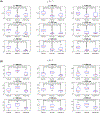Adaptive Boosting (AdaBoost)-based multiwavelength spatial frequency domain imaging and characterization for ex vivo human colorectal tissue assessment
- PMID: 32125775
- PMCID: PMC7593835
- DOI: 10.1002/jbio.201960241
Adaptive Boosting (AdaBoost)-based multiwavelength spatial frequency domain imaging and characterization for ex vivo human colorectal tissue assessment
Abstract
The current gold standard diagnostic test for colorectal cancer remains histological inspections of endoluminal neoplasia in biopsy specimens. However, biopsy site selection requires visual inspection of the bowel, typically with a white-light endoscope. Therefore, this technique is poorly suited to detect small or innocuous-appearing lesions. We hypothesize that an alternative modality-multiwavelength spatial frequency domain imaging (SFDI)-would be able to differentiate various colorectal neoplasia from normal tissue. In this ex vivo study of human colorectal tissues, we report the optical absorption and scattering signatures of normal, adenomatous polyp and cancer specimens. An abnormal vs. normal adaptive boosting (AdaBoost) classifier is trained to dichotomize tissue based on SFDI imaging characteristics, and an area under the receiver operating characteristic (ROC) curve (AUC) of 0.95 is achieved. We conclude that AdaBoost-based multiwavelength SFDI can differentiate abnormal from normal colorectal tissues, potentially improving endoluminal screening of the distal gastrointestinal tract in the future.
Keywords: AdaBoost; colorectal cancer; spatial frequency domain imaging.
© 2020 WILEY-VCH Verlag GmbH & Co. KGaA, Weinheim.
Conflict of interest statement
CONFLICT OF INTEREST
The authors declare no financial or commercial conflict of interest.
Figures






References
Publication types
MeSH terms
Grants and funding
LinkOut - more resources
Full Text Sources
Medical

